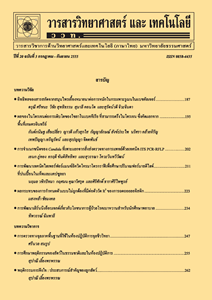Filtration Efficiency of Surgical Masks, Fabric Masks and N95/KN95/FFP1/FFP2 Masks Available for Use during the COVID-19 Pandemic in Thailand
Main Article Content
Abstract
This work aims to experimentally study the particle filtration efficiency of surgical masks, fabric masks, and N95/KN95/FFP1/FFP2 masks available during the COVID-19 pandemic in Thailand. In this study, 259 samples of commercially available covers consisted of 67 samples of surgical masks, 71 pieces of fabric masks, and 121 instances of N95/KN95/FFP1/FFP2 masks. It was carried out by the ASTM F2299-03 standard test method for determining the filtration efficiency with polystyrene latex sphere particles at a face velocity of about 10.6 cm/s. The results showed that the surgical masks have average, minimum, maximum, and standard deviation of particle filtration efficiencies of 50.50, 2.50, 95.90, and 26.34 %, respectively. The fabric masks have those efficiencies of 39.10, 5.93, 87.55, and 19.64 %, respectively, while the N95/KN95/FFP1/FFP2 masks efficiencies are 72.21, 8.92, 99.97, and 26.65 %, respectively. Also, the principle of particle filtration, structure, and components of a face mask is explained in this paper. This information is beneficial to both consumers and interested peoples.
Article Details
References
Department of Disease Control, COVID-19 Situation Report, Available Source: https://covid19.ddc.moph.go.th, October 24, 2020. (in Thai)
O’Dowd, K., Nair, K.M., Forouzandeh, P., Mathew, S., Grant, J., Moran, R., Bartlett, J., Bird, J. and Pillai, S.C., 2020, Face masks and respirators in the fight against the COVID-19 pandemic: A review of current materials, Adv. Future Perspect. Mater. 13(15): 3363.
El-Atab, N., Qaiser, N., Badghaish, H., Shaikh, S.F. and Hussain, M.M., 2020, Flexible nanoporous template for the design and development of reusable anti-COVID-19 hydrophobic face masks, ACS Nano 14: 7659-7665.
Sickbert-Bennett E.E., Samet, J.M., Clapp, P.W., Chen, H., Berntsen, J., Zeman, K.L., Tong, H., Weber, D.J. and Bennett, W.D., 2020, Filtration efficiency of hospital face mask alternatives available for use during the COVID-19 pandemic, JAMA Int. Med. 180: 1607-1612.
Konda, A., Prakash, A., Moss, G.A., Schmoldt, M., Grant, G.D. and Guha, S., 2020, Aerosol filtration efficiency of common fabrics used in respiratory cloth masks, ACS Nano 14: 6339-6347.
Aydin, O., Emon, B., Cheng, S., Hong, L., Chamorro, L.P. and Saif, M.T.A., 2020, Performance of fabrics for home-made masks against the spread of COVID-19 through droplets: A quantitative mecha nistic study, Extreme Mechanics Lett. 40: 100924.
Rengasamy, S., Eimer, B. and Shaffer, R.E., 2010, Simple respiratory protection – Evaluation of the filtration performance of cloth masks and common fabric materials against 20-1,000 nm size particles, Ann. Occupat. Hyg. 54: 789-798.
Whiley, H., Keerthirathne, T.P., Nisar, M.A., White, M.A.F. and Ross, K.E., 2020, Viral filtration efficiency of fabric masks compared with surgical and N95 masks, Pathogens 9: 762-769.
Dugdale, C.M. and Walensky, R.P., 2020, Filtration efficiency, effectiveness, and availability of N95 face masks for COVID-19 prevention, JAMA Int. Med. 180: 1612-1613.
ASTM F2299/F2299M-03(2017), 2017, Standard Test Method for Determining the Initial Efficiency of Materials Used in Medical Face Masks to Penetration by Particulates Using Latex Spheres, ASTM International, West Conshohocken, PA.
ASTM F2100-19e1, 2019, Standard Specification for Performance of Materials Used in Medical Face Masks, ASTM International, West Conshohocken, PA.
Willeke, K. and Baron, P.A., 1993, Aerosol Measurement: Principles, Techniques, and Applications, John Wiley & Sons, New York.
Liu, B.Y.H. and Pui, D.Y.H., 1974, Equilibrium bipolar charge distribution of aerosols, J. Colloid Interf. Sci. 49: 305-312.


